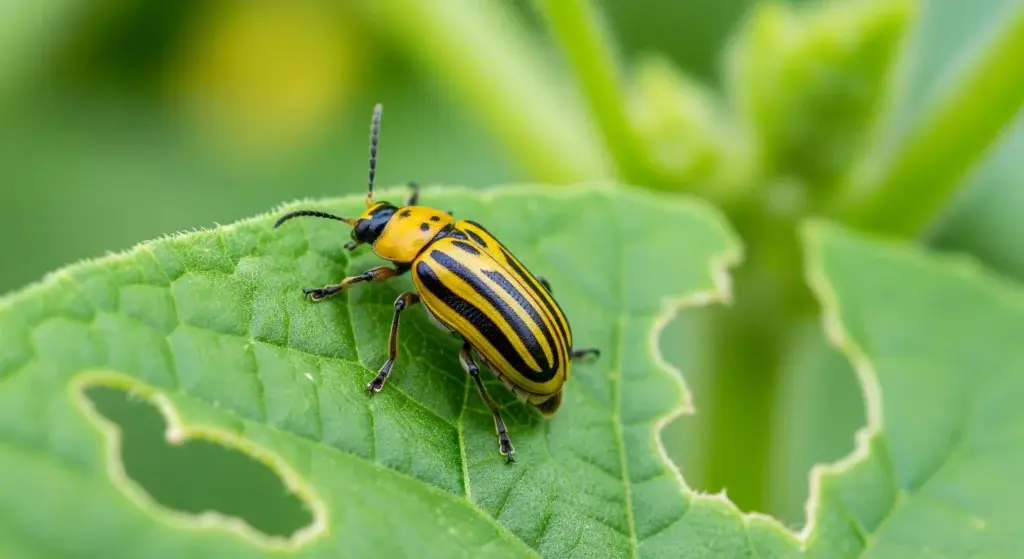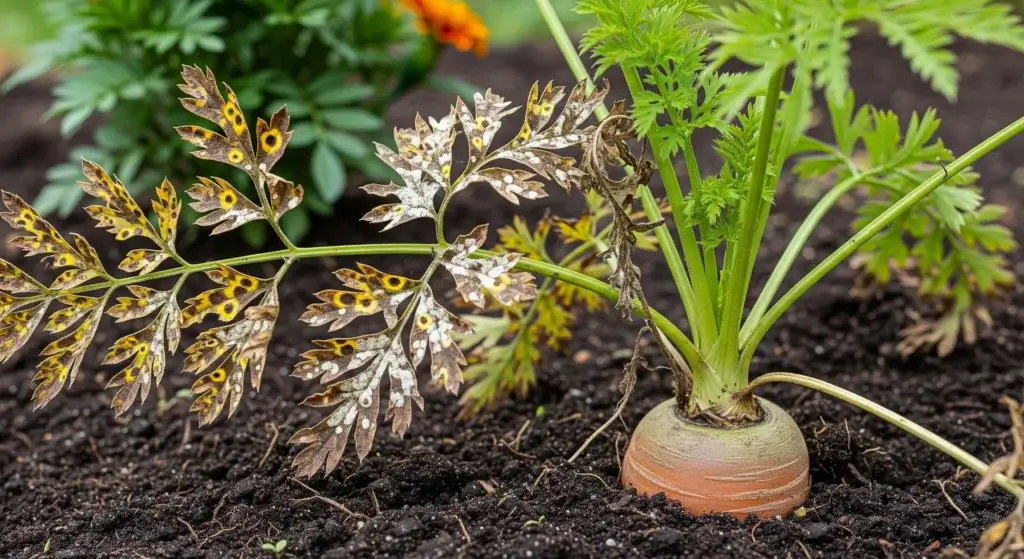
Every gardener’s dream of bulging cucumbers can flip into a full-on betrayal when tiny yellow-and-black striped invaders show up overnight.
The striped cucumber beetle (Acalymma vittatum) — about a quarter-inch long — munches leaves, chews stems, and spreads nasty diseases, wrecking gardens and costing farmers big bucks.
I’ve seen a whole cucumber patch go from thriving to tragic in a weekend; trust me, these little guys punch way above their weight.
What is a Striped Cucumber Beetle?
Meet the striped cucumber beetle — tiny, flashy, and absolutely evil if you grow cucumbers.
These little bugs, only about 4–5 millimeters long, rock bright yellow-orange bodies with three black racing stripes.
Don’t be fooled by their good looks; they’re garden villains in disguise.
Physical Characteristics
Adults look like they’re wearing tiny sports jerseys — yellow with black stripes — but they use that flashy look to warn predators they taste gross (a defense called aposematism).
Their babies, though? Total opposites.
The larvae are pale, squirmy worm-like things hiding underground, chewing on roots where you can’t see them.
So yeah, they attack from above and below.
Geographic Distribution and Lifecycle
These pests are all over North America, especially east of the Rockies, wherever cucumbers, squash, or melons grow.
When spring hits and the soil warms up to about 55°F (13°C), they crawl out from hiding — leaf piles, woodpiles, your nightmares — and head straight for your young plants.
Females lay hundreds of eggs near the base of stems, and in a few weeks, a new generation hatches ready to party (and by party, I mean destroy your garden).
Their whole life cycle only takes about 6–9 weeks, which means multiple waves of chaos per year.
Why Striped Cucumber Beetles Are Problematic
Striped cucumber beetles aren’t just annoying — they’re double trouble.
They destroy plants with their chewing and spread deadly diseases. It’s like they’re running a full-scale garden crime syndicate.
Direct Feeding Damage
These little jerks munch right through leaves, flowers, even the fruit if you let ‘em.
If a bunch of them show up, say goodbye to your baby cucumber plants—they’ll demolish the whole thing overnight like it’s nothing.
Not even exaggerating—research says just five or ten of these guys can totally kill a seedling.
Picture a mini bug mafia taking out your veggies while you sleep. And it gets worse: on bigger plants, they’re all about messing up the flowers, so good luck getting any cucumbers later.
Meanwhile, the larvae are busy underground, secretly chewing on the roots.
Your plants start looking sad and floppy, and you don’t even realize it’s those sneaky grubs wrecking the place.
Disease Transmission
As if the chewing wasn’t bad enough, they also spread bacterial wilt — basically a plant plague.
Once a beetle carrying the bacteria bites a healthy plant, it’s game over.
The infection clogs up the plant’s “veins,” causing sudden wilting and death.
There’s no cure — you just have to rip the plant out.
To make things worse, they can also spread cucumber mosaic virus and other nasties, turning a small infestation into a full-blown garden apocalypse.
Host Plants and Crop Vulnerability
Striped cucumber beetles have favorite snacks, and cucumbers top the menu every time.
But when they’re hungry, they’ll munch on pretty much anything in the cucurbit family — the plant version of raiding the fridge at midnight.
Most Susceptible Crops
Cucumbers are basically beetle crack—doesn’t matter if they’re the slicing kind or those little picklers, they’re always the first to get destroyed.
Muskmelons and cantaloupes? Yeah, they’re next in the line of fire, usually ending up all limp and pathetic.
Summer squash and zucchini aren’t safe either; beetles treat them like an open bar.
Pumpkins and winter squash only catch a break when the tastier stuff runs out, like they’re the leftovers nobody wants.
And watermelons? Think of them as the sad potato salad at a potluck—ignored until desperation kicks in.
Beyond Cucurbits
If the beetles get desperate, sure, they’ll nibble on random plants like beans, peas, or corn, but that’s more of a “meh, I’m bored” snack than actual destruction.
Identification and Monitoring Strategies
Early detection = saving your cucumbers. Catching striped cucumber beetles before they go viral on your vines is the single best move to keep your plants alive and your harvest not tragic.
Scouting Techniques
Begin watching as soon as seedlings pop up or you transplant.
For the first 3–4 weeks—when plants are basically baby tomatoes but for cucurbits—check at least twice a week. Look for:
- Undersides of leaves — beetles love to hide there during the hot part of the day. Peek beneath the foliage like a detective.
- Flowers and young fruit — adults cluster here to snack and wreck the show. If the flowers look chewed, that’s their party spot.
- Soil at the base — dig around gently for larval activity or tiny egg clusters. These pests hit you from underground, too.
- Wilting plants — sudden droopiness can mean bacterial wilt, not just thirst. Don’t ignore dramatic wilting.
Yellow Sticky Traps
Yellow sticky traps are the garden’s radar.
They attract adults and let you see population trends — place them at plant height around the beds and inside the patch.
Check them every 2–3 days to see if numbers are climbing.
They’re awesome for monitoring, but don’t expect them to solve the infestation alone — think of them as your beetle early-warning system, not the whole army.
Integrated Pest Management Strategies
Managing striped cucumber beetles means mixing tricks — don’t trust one move to win the war.
Think chess, not whack-a-mole.
Cultural Control Methods
- Crop rotation — swap cucurbits out for at least two years in the same spot. Beetles overwinter nearby; move the party and they’ll lose the GPS.
- Timing of planting — plant smart. Delaying can let seedlings grow past the beetle-slaying window; planting very early can let plants mature before beetles show up..
- Sanitation practices — Remove crop debris, yank weeds that hide beetles, and ditch piled-up mulch or brush where they bunk down for winter.
- Trap cropping — plant a beetle magnet (like Blue Hubbard squash) around your plot. Let the beetles congregate there, then knock ’em back.
Physical Barriers
- Row covers — lightweight fabric covers are golden for babies. Put them on right after planting, seal the edges, and keep beetles out.
- Mulching — straw or reflective plastic mulch can confuse beetles and discourage egg-laying.
Biological Control
- Beneficial nematodes — Tiny worm-like creatures attack beetle larvae underground. Apply them when soil is warm and keep it moist — they’re like invisible assassins doing the dirty work.
- Predatory insects — like ground beetles, assassin bugs, and certain parasitic wasps — hunt cucumber beetles.
- Entomopathogenic fungi — like Beauveria bassiana infect and kill beetles naturally. They take a few days to kick in and need humidity, but they’re legit biological warriors.
Chemical Control Options
When beetle pressure gets out of hand, targeted insecticides can protect young plants. Use them responsibly.
Organic Choices:
- Pyrethrin sprays — fast knockdown, but don’t last long; you’ll need repeat applications.
- Neem oil — repels and messes with feeding behavior.
- Spinosad — a naturally derived option that’s effective and lower-impact.
- Kaolin clay (Surround®) — forms a particle film that deters feeding and egg-laying.
Conventional Options:
Carbaryl, permethrin, and some neonicotinoids give longer control but hit the environment harder.
Follow labels, respect pre-harvest intervals, and don’t spray while bees are working flowers.
Seed Treatments
Systemic protection is an option for commercial growers but watch pollinator-safety issues and local restrictions.
Chemical Application Best Practices
- Spray during early morning or evening — beetles are active and bees are not.
- Aim coverage at the undersides of leaves where beetles hide.
- Rotate insecticide classes to slow resistance.
- Use the lowest effective rate and avoid unnecessary applications to protect beneficial insects.
- Always read and follow label directions and safety rules.
Mixing tactics — cultural, physical, biological, and chemical — is how you win.
I’ve seen gardeners save whole patches by using two or three of these together; use the combo that fits your garden and don’t go lone-wolf.
Resistant Varieties and Breeding Efforts
Plant breeders are basically in a never-ending battle to create cucumbers and squash that can stand up to striped cucumber beetles — but so far, there’s no “super cucumber” that’s totally immune.
Some varieties are less tasty to beetles (imagine the veggie version of broccoli for picky kids) because they produce natural defense chemicals.
A few bitter squash types repel beetles better, but nobody wants to eat them — they taste like regret.
Scientists are working to blend those defensive traits with good flavor, but it’s tricky business.
As for bacterial wilt, that one’s even harder to crack. Some cucumbers labeled “wilt tolerant” can handle a bit of infection but still fold under heavy pressure.
So, don’t rely just on genetics.
When picking what to plant, check local extension recommendations and pair resistant varieties with other strategies — rotation, row covers, and all that good stuff. Resistance helps, but teamwork saves the harvest.
Conclusion
Striped cucumber beetles are like the ultimate garden villains — tiny, hungry, and annoyingly good at spreading plant diseases.
But they’re not unbeatable. With the right mix of smarts and strategy, you can totally outplay them.
Winning this fight takes consistency: keep scouting early, act fast when you spot them, and layer your defenses.
Row covers? Great for blocking attacks. Crop rotation and cleanup? Perfect for starving out future generations.
Add in biological helpers or careful chemical use when needed — it’s all about teamwork, not one big fix.



